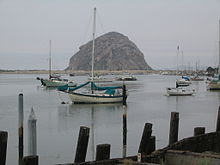- Morro Bay State Marine Recreational Management Area and Morro Bay State Marine Reserve
-
Morro Bay State Marine Recreational Management Area (SMRMA) and Morro Bay State Marine Reserve (SMR) are two marine protected areas that provide protection for Morro Bay Estuary on California’s central coast. The two marine protected areas together encompass 3.31 square miles (8.6 km2). Within the SMRMA fishing and take of all living marine resources is prohibited except that north of latitude 35° 19.70’ N the recreational take of finfish and aquaculture of oysters, pursuant to a valid State water bottom lease and permit, is permitted. And recreational hunting of waterfowl is allowed unless otherwise restricted by hunting regulations. The SMR protects all marine life within its boundaries. Fishing and take of all living marine resources is prohibited. [1]
Contents
History
Morro Bay State Marine Recreational Management Area and Morro Bay State Marine Reserve were established in September 2007 by the California Department of Fish & Game. They are two of 29 marine protected areas adopted during the first phase of the Marine Life Protection Act Initiative. The Marine Life Protection Act Initiative (or MLPAI) is a collaborative public process to create a statewide network of marine protected areas along the California coastline. [2]
Geography and natural features
The Morro Bay marine protected areas are near the city of Morro Bay and adjoin Morro Bay State Park. Morro Rock is a 581-foot volcanic plug located just offshore from Morro Bay, at the entrance to Morro Bay Harbor.
The Morro Bay SMRMA includes the area below mean high tide within Morro Bay east of the Morro Bay entrance breakwater and west of longitude 120° 50.34’ W.[3]
The Morro Bay SMR includes the area below mean high tide line within Morro Bay east of longitude 120° 50.34’ W.[4]
Habitat and wildlife
Morro Bay Estuary is one of the largest and most important wetland systems on the central coast, sustaining diverse habitats that support sensitive and endangered species. Morro Bay serves as an important resting and foraging ground for migratory birds using the Pacific Flyway. Large and diverse invertebrate populations inhabit the mudflats of the Bay; fish use the Bay as a nursery ground and dense meadows of eelgrass support a highly productive environment.[5]
Recreation and nearby attractions
Morro Bay supports a variety of recreational activities such as bird watching, sea kayaking, and recreational fishing, and is a working commercial and sport fishing harbor.
Area parks include Morro Bay State Park, Morro Strand State Beach and Montana de Oro State Park which provide hiking trails and campgrounds. Morro Bay State Park includes a Museum of Natural History.
California’s marine protected areas encourage recreational and educational uses of the ocean.[6] Activities such as kayaking, diving, snorkeling, and swimming are allowed unless otherwise restricted.
Scientific monitoring
As specified by the Marine Life Protection Act, select marine protected areas along California’s central coast are being monitored by scientists to track their effectiveness and learn more about ocean health. Similar studies in marine protected areas located off of the Santa Barbara Channel Islands have already detected gradual improvements in fish size and number.. [7]
Local scientific and educational institutions involved in the monitoring include Stanford University’s Hopkins Marine Station, University of California Santa Cruz, Moss Landing Marine Laboratories and Cal Poly San Luis Obispo. Research methods include hook-and-line sampling, intertidal and scuba diver surveys, and the use of Remote Operated Vehicle (ROV) submarines.
References
- ^ California Department of Fish and Game. "Online Guide to California’s Central Coast Marine Protected Areas". Retrieved on December 18, 2008
- ^ California Department of Fish and Game. "Online Guide to California’s Central Coast Marine Protected Areas". Retrieved on December 18, 2008
- ^ California Department of Fish and Game. "Central Coast Marine Protected Areas". Retrieved December 18, 2008.
- ^ California Department of Fish and Game. "Central Coast Marine Protected Areas". Retrieved December 18, 2008.
- ^ Department of Fish and Game. "Appendix O. Regional MPA Management Plans". Master Plan for Marine Protected Areas (approved February 2008). Retrieved December 18, 2008.
- ^ Department of Fish and Game. "California Fish and Game Code section 2853 (b)(3)". Marine Life Protection Act. Retrieved December 18, 2008.
- ^ Castell, Jenn, et al. "How do patterns of abundance and size structure differ between fished and unfished waters in the Channel Islands? Results from SCUBA surveys". Partnership for Interdisciplinary Studies of Coastal Oceans (PISCO) at University of California, Santa Barbara and University of California, Santa Cruz; Channel Islands National Park. Retrieved December 18, 2008.
External links
Categories:- Marine reserves of the United States
Wikimedia Foundation. 2010.

